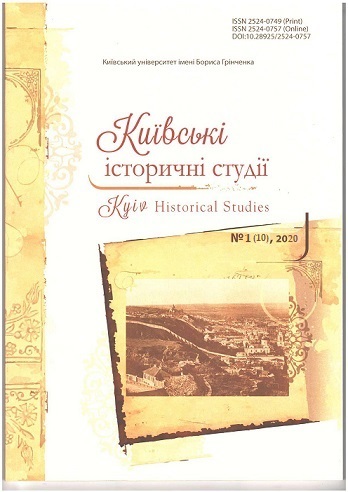LVIV ACCOUNT BOOK AS A SOURSE FOR THE SOCIAL STRATIFICATION OF THE TOWN IN THE FIRST HALF OF THE 15TH CENTURY
DOI:
https://doi.org/10.28925/2524-0757.2020.1.7Keywords:
Lviv, accounts book, szos taxes, citizens, propertiesAbstract
The article is devoted to one of the elder town’s income-expenditure book which is considered as a source for the social stratification of the city of Lviv from 1404 to 1414. The main problems which are stated from the analysis of the book’s registries (registrum) connected to the citizen’s status and their occupation. It is also revealed the peculiarities of the connections between the city authorities and inhabitants. The account registries of the book exposed the average quantity of the dwellers who were obliged to pay a different kind of taxes, especially a szos which was levied from the citizens who had the property. Additionally, it showed that the registrum of the book could also be interpreted not only as an economic constituent of Lviv in the 15th century but also as a source for the depiction of the various spheres of citizen lives. For instance, the taxes registers provided a broad range of communities which were engaged in merchantry, craftsmanship, renovation work, and light manufacturing. We could find in the sources their titles, names, and sort of occupation. Notably, most of the citizens who were involved in a different kind of work received from the town’s government encouragement in the form of monetary payments and another benefit. The texts of the registries at the book have also shown capitulary of the middle ages Lviv streets. According to this, my presumption was stated to account how many dwellers had lived at the one the street and even if they did how it is calculated due to the average amount of Lviv’s citizens. Forasmuch as the Polish historian Stanislaw Kutrzeba idea was stated that at the beginning of the 15th century it was at least 2481 citizens of Lviv.
Downloads
References
Kapral, M. (1997). Vlasnyky nerukhomosti na lvivskykh peredmistiakh u druhii chverti XVI st. (za materialamy chynshovykh reiestriv). Visnyk Lvivskoho universytetu, Seriia istorychna, 32, 188–189 [in Ukrainian].
Kapral, M. (1997). Vlasnyky nerukhomosti seredmistia Lvova 30–40-kh rokiv XVI stolittia u svitli shosovykh reiestriv (Sotsiotopohrafichnyi aspekt). Zapysky Naukovoho tovarystva imeni Shevchenka, ССХХХIII, 148–181 [in Ukrainian].
Kapral, M. (1996). Demohrafiia Lvova XV — pershoi polovyny XVI st. Lviv. Istorychni narysy, Upor. Ya. Isaievych, F. Steblii, M. Lytvyn, 67–81 [in Ukrainian].
Kapral, M. (1994). Stanovo-profesiina struktura naselennia Lvova u druhii chverti XVI st. (za materialamy miskykh rakhunkovykh knyh). Ukraina v mynulomu, V, I7–34 [in Ukrainian].
Kapral, M. (2006). Funktsionuvannia orhaniv vlady Lvova u XIII–XVIII st. (narys istorii instytutiv magdeburzkoho prava). Ukrainskyi istorychnyi zhurnal, 5, 111–130 [in Ukrainian].
Charewiczowa, Ł. (1934). Wodociągi starego Lwowa. 1404–1663. Lwów [in Polish].
Czołowski, A. (1896). Księga przychodów i rozchodów miasta 1404–1414. Pomniki dziejowe Lwowa. T. II. Lwów [in Polish and Latin].
Kapral, M. (2008). Urzędnicy miasta Lwowa w XIII–XVIII wieku. Wydawnictwo Adam Marszałek. Toruń [in Polish and Latin].
Kozubska-Andrusiv, O. (2015). Urban Elites of Lviv: emergence, development, and self-representation. In: Social and Political Elites in Eastern and Central Europe (15th–18th centuries). Ed. Radvan, Laurentiu and Luca Cristian. London, 35–64 [in English].
Kutrzeba, S. (1900). Szos we Lwowie w pączatkach XV wieku. Przewodnik Naukowy i Literacki R.XVIII: dodatek do “Gazety Lwowskiej”. Lwów [in Polish].
Łoziński, W. (1892). Patrycjat i mieszczaństwo lwowskie w XVI i XVII wieku. Lwów: Gubrynowicz i Schmidt [in Polish].
Pashyn, S. (2001). Peremyshlskaia shliakhta vtoroi polovyny XIV — nachala XVI vv, Tiumen [in Russian].
Petrišak, B. (2013). Pisarze miejscy lwowscy jako testatorzy i spadkobiercy od XIV do pierwszej połowy XVII wieku. Kwartalnik Historii Kultury Materialnej, 61 (2), 281–300 [in Polish].
Prochaska, A. (1919). Lwów a szlachta. Lwów: Towarzystwo Miłośników Przeszłości Lwowa. [in Polish].
Ptaśnik, J. (1925). Walki o demokratyzacje Lwowa od XVI do XVIII wieku. Lwów [in Polish].
Samsonowicz, H. (1986). Dzieje miast i mieszczaństwa w Polsce przedrozbiorowej. Wrocław: Zakład Narodowy im. Ossolińskich [in Polish].
Smutok, I. (2013). Rodovyi sklad shliakhty Peremyshlskoi zemli u XV— na pochatku XVII st. Rocznik Lubelskiego Towarzystwa Genealogicznego, T. 5 [in Ukrainian].
Sperka, J. (2010). Początki osadnictwa rycerstwa śląskiego na Rusi Czerwonej. Knyazha doba: istoriya i kultura, 3, 278–301 [in Polish].
Tandecki, J. (2015). Dokumenty i kancelarie mieskie. Dyplomatyka staropolska; pod redakcją Tomasza Jureka, 407–445. Warszawa [in Polish].
Wyrozumska B. (1995) Kancelaria miasta Krakowa w średniowieczu. Kraków [in Polish].
Published
How to Cite
Issue
Section
License
Copyright (c) 2020 Єлизавета П’янкова

This work is licensed under a Creative Commons Attribution-NonCommercial-ShareAlike 4.0 International License.
Authors who publish in this journal retain the right of authorship of the work and give to the journal right of first publication of this work under the conditions of Creative Commons: Attribution-NonCommercial-ShareAlike 4.0 International (CC BY-NC-SA 4.0), which allows others freely distribute the work published with reference to the authors of the original work and the first publication of this magazine.














